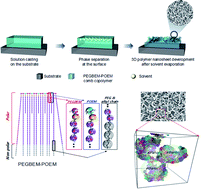Substrate-independent three-dimensional polymer nanosheets induced by solution casting†
Abstract
Nanosheets are important structures usually composed of inorganic materials, such as metals, metal oxides, and carbon. Their creation typically involves hydrothermal, electrochemical or microwave processes. In this study, we report a novel formation mechanism of 3D polymer nanosheets via facile solution casting using a comb copolymer consisting of poly(ethylene glycol) behenyl ether methacrylate and poly(oxyethylene) methacrylate (PEGBEM–POEM). Controlling the composition of comb copolymer yielded nanosheets with different packing density and surface coverage. Interestingly, the structure exhibits substrate independence as confirmed by glass, inorganic wafer, organic filter paper, and porous membrane. The formation of 3D nanosheets was investigated in detail using coarse-grained molecular dynamics simulations. The obtained polymer nanosheets were further utilized as templates for inorganic nanosheets, which exhibit high conductivity owing to interconnectivity, and hence have promising electronic and electrochemical applications.



 Please wait while we load your content...
Please wait while we load your content...